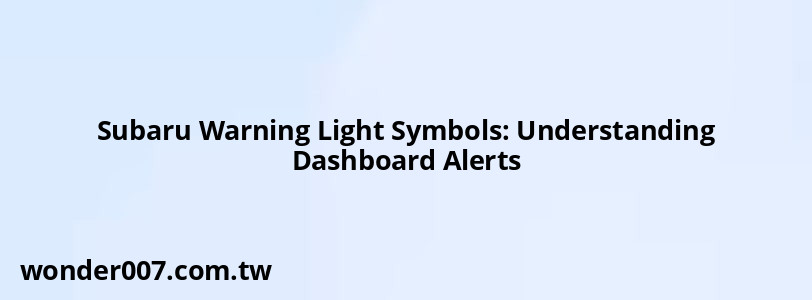Subaru Warning Light Symbols: Understanding Dashboard Alerts

Understanding the warning light symbols on your Subaru's dashboard is crucial for maintaining vehicle safety and performance. These symbols serve as alerts for various issues, ranging from minor notifications to serious malfunctions. Subaru owners often seek clarity on these indicators to ensure timely maintenance and avoid potential damage.
Common Subaru Warning Lights
Subaru vehicles feature a variety of warning lights, each with its specific meaning. Here are some of the most common symbols you may encounter:
- Check Engine Light: This light indicates a potential issue with the engine. If it’s solid, schedule maintenance; if it’s flashing, stop driving immediately and seek professional help.
- Oil Pressure Warning Light: This symbol appears when oil pressure is low. It's critical to address this immediately to prevent engine damage.
- Tire Pressure Warning Light: This light signals that one or more tires may be under-inflated. Check tire pressures and inflate as needed.
- ABS Warning Light: Indicates a problem with the Anti-lock Braking System. Immediate inspection is recommended to ensure braking safety.
- Battery Charge Warning Light: This light suggests issues with the battery or charging system. If illuminated, have the electrical system checked promptly.
- Brake System Warning Light: This can indicate low brake fluid or a malfunction in the braking system. Immediate attention is necessary for safety.
- Engine Temperature Warning Light: If this light is on, your engine may be overheating. Pull over safely and let the engine cool down before checking coolant levels.
Understanding Light Colors
The colors of warning lights provide insight into their severity:
- Red Lights: Indicate serious issues that require immediate attention. You should stop driving as soon as it’s safe to do so.
- Yellow/Amber Lights: Suggest problems that need addressing soon but are not immediately critical. You can usually continue driving but should plan for repairs.
- Green/Blue Lights: Typically informational, indicating that a system is active (e.g., cruise control).
Responding to Warning Lights
When you see a warning light:
1. Identify the Symbol: Refer to your owner’s manual or a reliable guide to understand what the light represents.
2. Assess Severity: Determine if it’s a red (urgent) or yellow (advisory) light.
3. Take Action: For red lights, pull over safely and investigate or call for assistance. For yellow lights, plan for repairs at your earliest convenience.
4. Regular Maintenance: Keep up with routine checks and services to minimize the risk of warning lights appearing unexpectedly.
FAQs About Subaru Warning Lights
- What does a flashing check engine light mean?
A flashing check engine light indicates a severe issue that requires immediate attention. - How can I reset my tire pressure warning light?
After inflating your tires to the correct pressure, drive for a few minutes; the light should reset automatically. - Is it safe to drive with the oil pressure warning light on?
No, driving with this light on can cause significant engine damage; stop driving immediately.
Related Posts
-
Hyundai Sonata: Understanding the Red Light on Your Dashboard
28-01-2025 • 166 views -
Service Suspension System: Understanding the Chevy Tahoe Warning
27-01-2025 • 220 views -
P2A00 Nissan Code: Understanding and Troubleshooting
26-01-2025 • 173 views -
Lexus GX 460: Understanding Warning Lights and Their Meanings
26-01-2025 • 258 views -
VW Atlas: Understanding the Coolant Warning Light
26-01-2025 • 163 views
Latest Posts
-
2015 Chevy Traverse AC Recharge Port Location
01-02-2025 • 366 views -
Power Steering Fluid Leak On Passenger Side
01-02-2025 • 420 views -
Are O2 Sensors Covered Under Warranty
01-02-2025 • 339 views -
How To Turn Off Paddle Shifters Mercedes
01-02-2025 • 335 views -
Rear Brake Caliper Piston Won't Compress
01-02-2025 • 315 views
Popular Posts
-
EPC Light: Understanding Causes and Solutions
26-01-2025 • 1019 views -
EPC Warning Light: What It Means for Your Vehicle
27-01-2025 • 591 views -
V12 Engine Costs: What You Need to Know
26-01-2025 • 633 views -
Hino Warning Lights: Understanding Dashboard Alerts
26-01-2025 • 636 views -
Power Steering and ABS Light On: Causes and Solutions
27-01-2025 • 613 views
